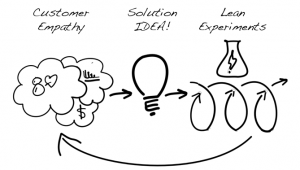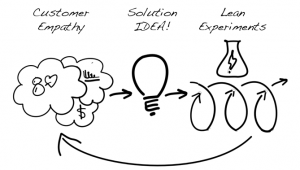Lean Innovation: Design Thinking Meets Lean Startup For The Enterprise
Innovation is often born from individuals who view design as a way to shape forward-thinking ideas. While design alone can’t deliver the promise of innovation, frameworks—such as design thinking and lean innovation —provide methodologies and a mindset that are required for customer-centric solutions.
Recently, I met with Brant Cooper, co-founder of Moves the Needle, which brings an entrepreneurial spirit to the enterprise, and New York Times bestselling author of The Lean Entrepreneur. We spoke about two of my favorite topics: Driving innovation in the enterprise and applying design thinking as an enabler of forward-thinking ideas that spur growth and profitability.
Kaan Turnali: Eric Ries, the author of The Lean Startup, talks about “bringing principles from lean manufacturing and agile development to the process of innovation.” He also wrote the foreword to your book. What is lean innovation? What common traits does it share with design thinking?
Brant Cooper: Lean innovation is design thinking plus lean startup tailored for the enterprise. Design-thinking principles are valuable gaining customer empathy and coming up with potential solutions to customer problems, needs, or desires. Lean startup’s rapid experimentation is the perfect next step after ideation. It takes the ethos of testing and applies it to the whole business model, from product to pricing to positioning to customer passion. Ultimately, it is the combination of design thinking and lean startup that helps organizations generate ideas, test them, and iterate their way to market success.

Kaan Turnali: When the term innovation or design thinking (or design in general for that matter) is used, it is often assumed that it applies only to new and revolutionary products. If it’s not a disruptive innovation, then it must not be innovative. If it’s not cutting-edge design or not another iPod, Google or Facebook, then it’s considered lightweight. What’s your perspective?
Brant Cooper: I like to look at it within an innovation spectrum with incremental innovation on the left, breakthrough innovation on the right. On the disruptive side, the focus is on learning and discovery of the unknown. Successful companies experiment their way through uncharted territory to discover new value that can be created, based on customer insights and market evidence.
On the left side, while you may not be creating the first iPhone, you are winning in existing markets important to maintaining the core business. On this sustaining side, the focus is innovating the business itself, so that people are more customer-focused and move with speed and agility. This includes internal processes such as how HR rolls out new services or how IT supports business units, as well as external processes including branding and marketing of existing products, and product changes based on new technologies already out in the market.

We had a sales team inside one of our client companies run an experiment to see why they were losing so many customers to expired credit cards. They called up a handful of these people and learned they still wanted the service – they just didn’t realize that card had expired. This tiny insight led to over $10 million dollars in new revenue by creating a workflow that proactively notifies people going forward. They also gained deep insights that their small business customers were suffering because of the financial crisis. What else could they do with this information that creates passionate and loyal customers?
Kaan Turnali: A lot of people assume that innovation requires additional resources. However in your book, you take a difference stance by writing, “organizations have the power, resources, and talent needed to continually innovate.” Personally, I see leadership as a key ingredient, but equally important is talent and culture. Take, for example, competing on design thinking. It requires a shift in mindset that emphasizes the importance of applying its principles rather than just the mechanics: “Don’t teach me design thinking, show me how to think in the design.” What have you seen organizations do to not only spark innovation but also scale it to deliver results that drive growth and profitability in the enterprise?
Brant Cooper: The most valuable resources are talent and culture. Although not everyone is an innovator, innovation can come from anywhere. The key then is to get people to work differently – to work in a way that empowers them to discover and create new value, no matter what their job title is.
Think about when product teams become more agile. They give creators (developers and product managers) the power to interact with their customers in order to discover ways to bring more value, without seeking permission from the hierarchy.
The same applies to developing the talent and culture needed to scale entrepreneurial thinking across the enterprise. Leaders must educate, enable, and empower employees to work differently. They also must walk the talk. Activities like empathy interviews, running experiments, and using evidence to make decisions should be regular practices, not slogans.
Kaan Turnali: To me, empathy is the most important design-thinking principle, followed by a “fail early fail often” mindset that encourages rapid prototypes and proof of concepts. I believe that empathy lies within the depths of our passion and tenacity, leading to an obsession with customer-centric innovation. How does lean innovation approach empathy?
Brant Cooper: We do design thinking. It’s one of the three core pillars of lean innovation: empathy, experiments, and evidence.
The challenge we saw enterprises face with design thinking comes after empathy. Prototyping comes during ideation, and teams either have trouble turning empathy into products that impact the business, or go straight into scoping and development. In other words, after empathy, they go back to a waterfall approach. In many organizations, design thinking stops at rapid prototyping and teams are left asking, “Now what?”
But that’s where the beauty of the cross section of lean startup and design thinking lies, or what we like to call “lean innovation.”
Instead of rapid prototyping and ideation after empathy, we’re focused on rapid experimentation. Testing whether the assumptions that need to be true for solutions to impact the business are indeed true before allocating precious time, money, and talent.
Design thinking and generating deep empathy is the beginning. Lean startup is the next step, helping you take action on those insights and iterating towards an impact on market success. Lean innovation is the whole thing – across the business model and specific to an enterprise context.
Kaan Turnali: An innovation culture is built on an invisible line that connects leadership and talent—engraved in authentic values, bold actions, and an entrepreneurial spirit that becomes contagious. Innovators understand that innovation isn’t a destination, but a never-ending pursuit of ideas that change the world around us.
All opinions expressed in this article are those of the interviewee and they do not reflect the opinions of SAP.
Kaan
Connect with me on Twitter (@KaanTurnali) and LinkedIn
